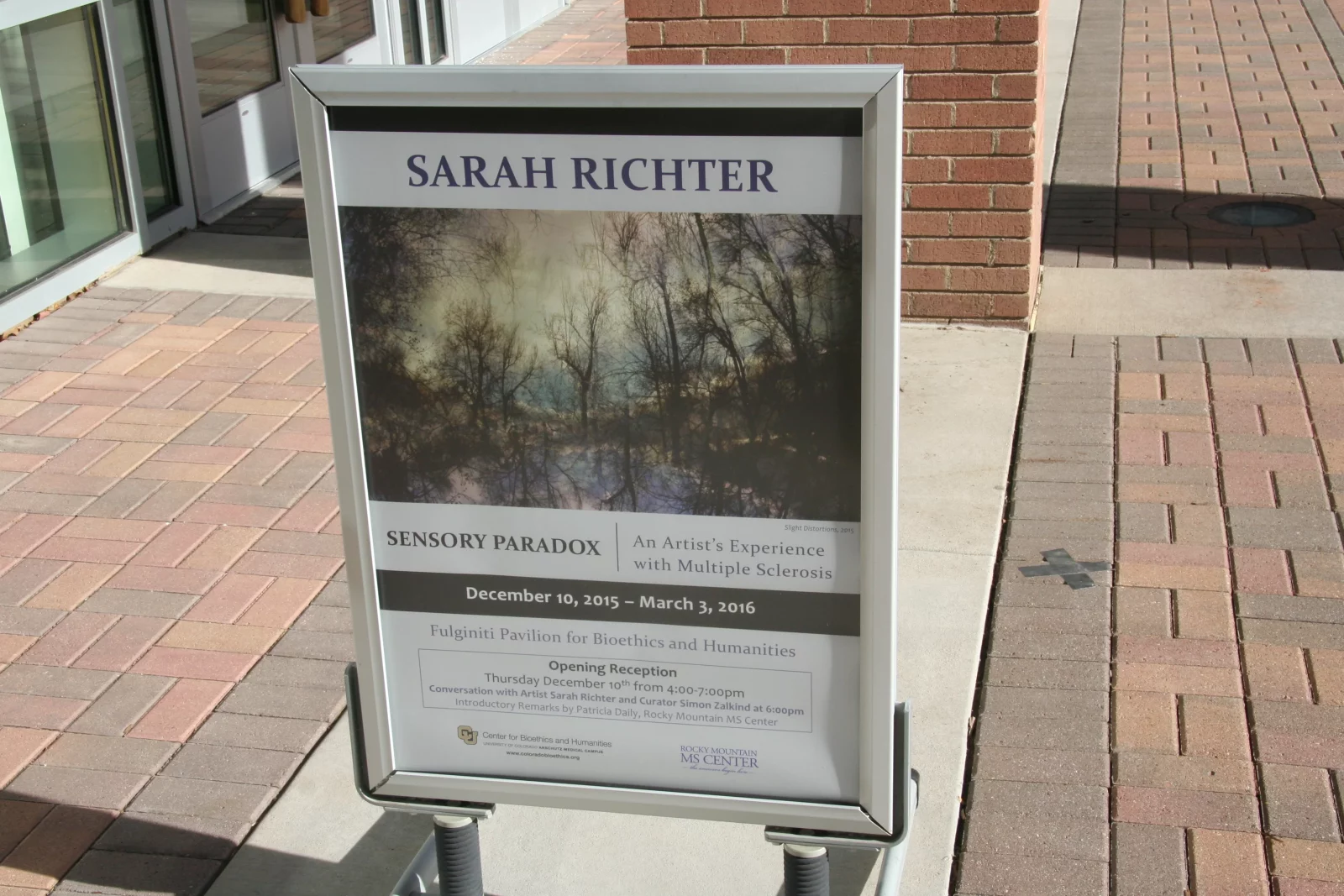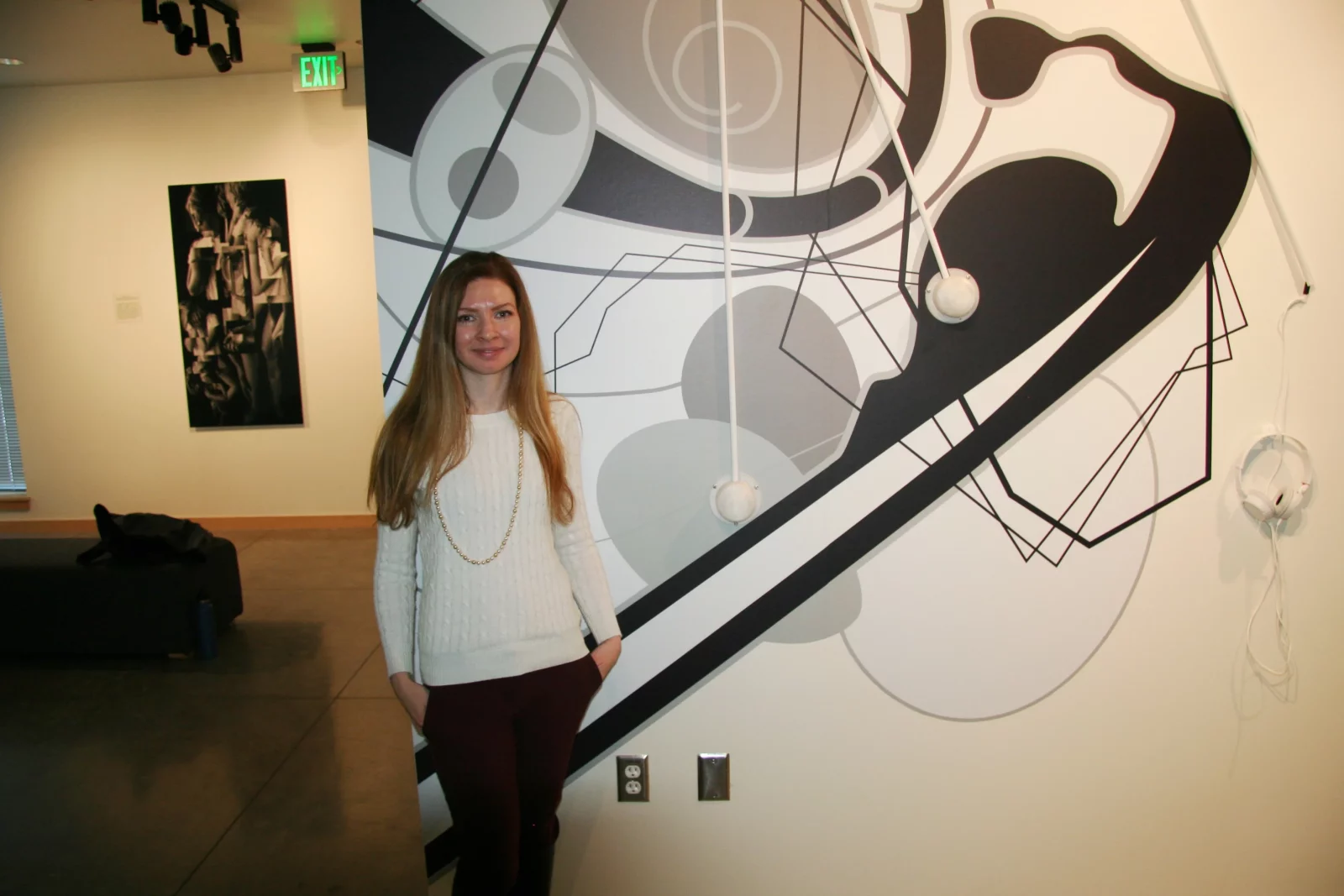One morning in 2009, Sarah Richter awoke to see the world from a new and frightening point of view. She had triple vision that wouldn’t clear. Adding to the disorientation was a powerful sense of vertigo.

“It was strange, horrible,” Richter said as she sat in the sunny lobby of The Art Gallery at the Fulginiti Pavilion for Bioethics and Humanities on the Anschutz Medical Campus late last month.
The nightmarish experience was the culmination of a steady period of decline for Richter, then 28. She had been slowed by fatigue that made it increasingly difficult to finish even simple tasks. After the triple-vision scare, she was often bedridden for seven months until she was diagnosed with multiple sclerosis (MS), a progressively debilitating neurological disease that leads to stiffness, difficulty walking, balance problems, and a host of other physical issues.

Some might have viewed the diagnosis as a bleak end to a disease-free life. Instead, Richter, now 34, looked ahead. With the help of neurologist Timothy Vollmer, MD, medical director of the Rocky Mountain MS Center and co-director of the Rocky Mountain MS Center at Anschutz Medical Campus, her disease is stable. But while she acknowledges the challenges MS continues to present her, Richter views the disease as a gift – an entrée into a new world of creative possibility.
“MS is one of the best things that ever happened to me,” she says.
Taking a fork in the road
After the diagnosis, Richter divorced and changed her artistic path, leaving behind a career as a children’s illustrator and pursuing a degree from the University of Denver in Emerging Digital Practices, a discipline that blends various media and technologies in the creation of fine art.

The evidence of the doors that the disease opened for Richter is on display in her exhibit, “Sensory Paradox,” now on display at The Art Gallery through March 3. It’s supported by the Rocky Mountain MS Center and a grant from Teva Pharmaceuticals.
The work is a multimedia representation of Richter’s experience with MS. The visitor sees and hears Richter’s disease-distorted world through video, audio, photographic, and design installations. There is even an interactive piece that invites the participant to photograph and display his or her own troublesome knee, ankle, or other body part on a corkboard and vinyl body figure affixed to the wall.
On one level, the exhibit is Richter’s attempt to draw the visitor into life with MS. In one striking piece titled “Fatigue,” video projected on a wall of the space shows a fully clothed figure submerged in water, struggling to take off his tie, button his shirt sleeves, tie his shoes, and other everyday tasks. Richter filmed the slow-motion battle to illustrate the physical toll she endured in her battle with the disease.
“It was a feeling of being underwater, that everything was heavy, that my gestures were slow, that I was putting in more and more effort on the same things,” she said. “It felt like I was slowing down and the world was speeding up.”
Another video installation, “Sight Distortions,” features four screens displaying what appear to be versions of shifting abstract imagery. Richter filmed the scenes with two cameras she carried on her shoulders through a park in the daytime and around a downtown Denver street at night. She edited the video to create a sense of the blurred, layered world of changing lights, colors, textures, and shapes that she experienced because of MS.
“These are invisible symptoms that are hard to understand,” Richter said. “I’m trying to describe for people things that are not easy to talk about.”

The upheaval that MS brought into her life is represented in “Re-construction,” a collage of black-and-white print photographs depicting pieces of an individual’s body. The disease shattered the way Richter perceived the world through her physical senses.
“Before MS, things seemed solid and fixed. After this experience, they’re not,” she said. “Nothing is certain.”
A fluid world
But “Re-construction” expresses another aspect of that change and the challenge it presented, Richter added. She had to accept and even welcome the fact that she would never again live the way she had. She saw that she had been given an opportunity to change her life in positive ways, but only if she accepted the reality of living with a life-altering disease and found ways to adapt. That meant facing uncertainty squarely.
“It’s frightening and disorienting, for example, to see lights in a way that is so different, but it is also magical and beautiful, with an ethereal quality,” Richter said. “It’s a fluid way of looking at the world.”
With “Sensory Paradox,” Richter asks the visitor to see things through her eyes, but adds that her aspirations for the exhibit go farther.

“It’s not just about me,” she said. “The exhibit is broad enough to take on different meanings for different people. We are all influenced by our senses, and that changes over time.”
Richter is respectful of all approaches to art – “every medium has a voice,” she says – but believes the multimedia techniques on display in “Sensory Paradox” are uniquely suited to introducing people to the landscape of her illness and making them fellow travelers.
“The new media is special in that it’s multisensory,” she said. Walking through the exhibit, the visitor simultaneously takes in eerie recorded sounds that illustrate Richter’s battles with the tinnitus caused by her MS; the floating imagery of “Fatigue”; and the oddly alluring disorientation of “Sight Distortions.”
Richter introduces visitors to a foreign land, but she hopes they will leave the exhibit not only with a greater understanding of her condition, but also with a determination to engage whatever challenges they may face rather than to seek escape.
“That’s an important part of the dialogue,” Richter said. “My disease is not just a set of symptoms. It’s about finding different ways to deal with it. It has helped me to become the person I needed to be.”
Ultimately, she said, MS provided an unyielding reminder that life is finite, and that it is up to individuals to carve meaning from their allotted time.
“You have to experience limits if you are to find your greatest potential,” Richter said.
